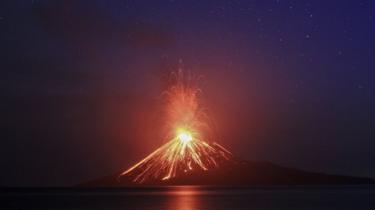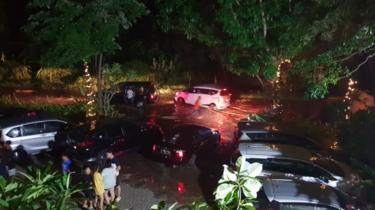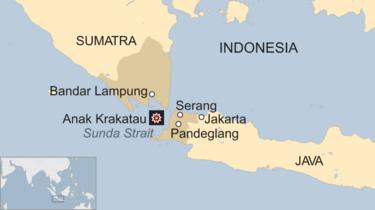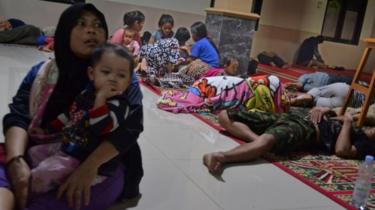Indonesia Tsunami Hits Sunda Strait After Krakatau Eruption

At least 168 people have been killed and 745 injured after a tsunami hit coastal towns on Indonesia’s Sunda Strait, government officials say.
The tsunami waves struck at night without any warning, destroying hundreds of buildings.
Officials say the tsunami could have been caused by undersea landslides after Anak Krakatau volcano erupted.
The Sunda Strait, between the islands of Java and Sumatra, connects the Java Sea to the Indian Ocean.
What is the latest?
The disaster management agency has warned people to stay away from the coastline due to fears of another tsunami.
Saturday’s tsunami struck at about 21:30 local time (14:30GMT), during a local holiday.
It hit several popular tourist destinations including the Tanjung Lesung beach resort in the west of Java island.
Deaths have been reported in the Pandeglang and Serang on Java, and Lampung province on Sumatra. Officials fear the death toll could rise further.
The BBC’s Rebecca Henschke in Indonesia said there were reports that the death toll in Lampung province alone could be in the hundreds.
Footage shared on social media showed a large wave crashing into a tent in the resort, in which a popular Indonesian rock band, Seventeen, was performing. Members of the band were seen being swept away as the wave destroyed the stage.
In a tearful Instagram video, singer Riefian Fajarsyah, said the band’s bassist and road manager had died, and that three other band members and his own wife were missing.
A crew member, Zack, said on Instagram that he survived by grabbing onto part of the stage, and “in the final seconds [underwater] I almost ran out of breath”, Reuters reported.

Red Cross official Kathy Mueller told the BBC: “There is debris littering the ground, crushed cars, crushed motorcycles, we’re seeing buildings that are collapsed.”
It appears that the main road into Pandeglang has been badly damaged, making it difficult for rescuers to reach the area, she added.
Eyewitness Asep Perangkat said “cars were dragged about 10 metres, and so were containers.”
“Buildings on the edge of [Carita] beach were destroyed, trees and electricity poles fell to the ground,” he told AFP news agency.
Sutopo Purwo Nugroho, national spokesman at Indonesia’s disaster agency, tweeted footage of the damage in Lampung.


Pantauan udara daerah terdampak tsunami di Pantai Kalianda Kabupaten Lampung Selatan. Korban dampak tsunami di Lampung Selatan per 23/12/2018 pukul 13.00 WIB: 35 orang meninggal duniq, 115 orang luka dan 110 unit rumah rusak. Pendataan masih dilakukan.
‘There were two waves’
Oystein Lund Andersen, Norwegian volcano photographer, Anyer Beach in West Java
I was on the beach. I was alone, my family were sleeping in a room.
I was trying to photograph the erupting Krakatau volcano.
Earlier in the evening, there was quite heavy eruption activity. But just prior to the waves hitting the beach, there was no activity at all. It was just dark out there.
And suddenly I saw this wave coming, and I had to run.
There were two waves. The first wave wasn’t that strong – I could run from it.

I ran straight to the hotel, where my wife and my son were sleeping.
And I woke them up… and I heard a bigger wave coming. I looked out of the window when the second wave hit. It was much bigger.
The wave passed the hotel. Cars were pushed off the road.
We and other people at the hotel went straight to the forest (on higher ground) next to the hotel. And we’re still up on the hill now.
– Oystein Lund Andersen was speaking to BBC World News television

What might have caused the tsunami?
Emergency officials are investigating whether the tsunami was caused by Anak Krakatau, a volcanic island in the Sunda Strait.
Volcanologist Jess Phoenix told the BBC that when volcanoes erupt, hot magma pushes underground and can displace and break through colder rock. This can trigger a landslide.
But because part of the volcano is underwater, she said “instead of just causing a landslide, you get an undersea landslide which pushes water as it moves.” This can then cause a tsunami.

The Anak Krakatau volcano has seen increased activity in recent months.
Indonesia’s geologic agency said that the volcano erupted for two minutes and 12 seconds on Friday, creating an ash cloud that rose 400 metres (1,300ft) above the mountain.
It recommended that no-one be allowed within two kilometres of the crater.

The disaster management agency said that high seas as a result of the full moon may also have contributed to the strength of the waves.
Were people warned?
The disaster agency spokesman, Mr Nugroho, initially said the wave was not a tsunami, but a tidal surge, and told the public not to panic.
He later apologised for the mistake, saying there had been confusion because there was no earthquake.
Meanwhile, earlier on Sunday, a tsunami warning went off by mistake, causing widespread panic.
“A tsunami siren in Labuhan Bay in Pandeglang regency started ringing all of a sudden, without any activation from the authorities,” Mr Nugroho said.
“There was possibly a technical error that made the sirens ring. Lots of people ran to save themselves… tsunami shelters are now packed.”
How common are tsunamis in Indonesia?

Indonesia is prone to tsunamis because it lies on the Ring of Fire – the line of frequent earthquakes and volcanic eruptions that circles virtually the entire Pacific rim.
In September, more than 2,000 people died when a powerful earthquake struck just off the central Indonesian island of Sulawesi, setting off a tsunami that engulfed the coastal city of Palu.
On 26 December 2004, a series of huge waves triggered by a powerful earthquake in the Indian Ocean killed about 228,000 people in 14 countries, mostly in Indonesia.
However, tsunamis caused by volcanic activity like this are less frequent.
Krakatoa (Krakatau in Indonesian)

Anak Krakatau (Child of Krakatau) is a new island that emerged in 1927 from Krakatoa volcano.
In August 1883, Krakatoa underwent one of the most violent volcanic eruptions in recorded history:
- Massive tsunamis with waves up to 135ft (41m) killed more than 30,000 people
- Thousands more were killed by hot ash
- The eruptions were equivalent to 200 megatons of TNT – about 13,000 times the nuclear yield of the bomb dropped on Hiroshima in 1945
- The eruptions were heard thousands of kilometres away
- World temperatures dropped by more than 1C the following year
- The volcanic island virtually disappeared



Comments